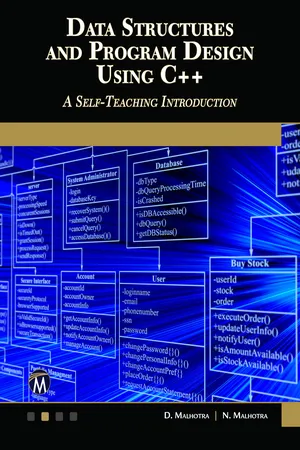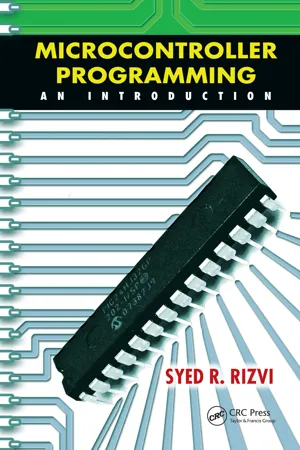Computer Science
Array C
Array C is a data structure in the C programming language that stores a collection of elements of the same data type. It is a contiguous block of memory that can be accessed using an index. Arrays in C are static, meaning their size is fixed at compile time.
Written by Perlego with AI-assistance
Related key terms
11 Key excerpts on "Array C"
- eBook - ePub
- D. Malhotra, N. Malhotra(Authors)
- 2019(Publication Date)
- Mercury Learning and Information(Publisher)
3ARRAYS
In This Chapter• Introduction• Definition of an array• Array declaration• Array initialization• Calculating the address of array elements• Analyzing an algorithm• Abstract data types• Declaration of two-dimensional arrays• Operations on 2-D arrays• Multidimensional arrays/ N-dimensional arrayys• Calculating the address of 3-D arrays• Arrays and pointers• Array of pointers• Arrays and their applications• Sparse matrices• Types of sparse matrices• Representation of sparse matrices• Summary• Exercises3.1Introduction
We have already studied the basics of programming in data structures and C++ in the previous chapter in which we aimed to design good programs, where a good program refers to a program which runs correctly and efficiently by occupying less space in the memory, and also takes less time to run and execute. Undoubtedly, a program is said to be efficient when it executes with less memory space and also in minimal time. In this chapter, we will learn about the concept of arrays. An array is a user-defined data type that stores related information together. Arrays are discussed in detail in the following sections.3.2Definition of an Array
An array is a collection of homogeneous (similar) types of data elements in contiguous memory . An array is a linear data structure because all elements of the array are stored in linear order. Let us take an example in which we have ten students in a class, and we have been asked to store the marks of all ten students; then we need a data structure known as an array.FIGURE 3.1 .Representation of an array of 10 elements.In the previous example, the data elements are stored in the successive memory locations and are identified by an index number (also known as the subscript), that is, Ai or A[i]. A subscript is an ordinal number which is used to identify an element of the array - eBook - ePub
Data Structures and Program Design Using Java
A Self-Teaching Introduction
- D. Malhotra, N. Malhotra(Authors)
- 2020(Publication Date)
- Mercury Learning and Information(Publisher)
3ARRAYS
3.1 Introduction
In the previous chapter we studied the basics of programming in data structures and Java in which we aimed to design good programs, where a good program refers to a program which runs correctly and efficiently by occupying less space in the memory, and also takes less time to run and execute. Undoubtedly, a program is said to be efficient when it executes with less memory space and also in minimal time. In this chapter, we will learn about the concept of arrays. An array is a user-defined data type that stores related information together. Arrays are discussed in detail in the following sections.3.2 Definition of an Array
An array is a collection of homogeneous (similar) types of data elements in contiguous memory. An array is a linear data structure, because all elements of the array are stored in linear order. Let us take an example in which we have ten students in a class, and we have been asked to store the marks of all ten students; then we need a data structure known as an array.Figure 3.1. Representation of an array of ten elements.In the previous example, the data elements are stored in the successive memory locations and are identified by an index number (also known as the subscript), that is, Ai or A[i]. A subscript is an ordinal number which is used to identify an element of the array. The elements of an array have the same data type, and each element in an Array Can be accessed using the same name.Frequently Asked Questions
1. What is an array? How can we identify an element in the array?Ans: An array is a collection of homogeneous (similar) types of data elements in contiguous memory. An element in an Array Can be identified by its index number, which is also known as a subscript.3.3 Array Declaration
We know that all variables must be declared before they are used in the program. Therefore, the same concept also holds with array variables. An array must be declared before it is used. During the declaration of an array, the size of the array has to be specified. Declaring an array involves the following specifications: - eBook - ePub
C Programming
Learn to Code
- Sisir Kumar Jena(Author)
- 2021(Publication Date)
- Chapman and Hall/CRC(Publisher)
10 Arrays and StringsDOI: 10.1201/9781003188254-1010.1 Introduction
Many times, we come across a situation where we use a set of data rather than a single datum. For example, assume that you are an instructor and you teach C programming. You want to store the marks of your students and later perform different types of operations on them, such as finding the top performer or knowing how many students secure less than 50 marks. In that case usage of a single variable is not enough: you need multiple variables to store the data of your students. Again, if you use many variables in your program then remembering those variable names will become difficult. So, the solution is the array – a concept provided by C that handles large numbers of items simultaneously.In our day-to-day life we also came across situations where we need to group items and keep them in a sequential manner for easy access. For example, Figure 10.1 shows a toy train built to store painting items such as watercolors, sketch pens, brushes, pencils, and oil pastels. We name this train the Painter’s Train. We number the boxes from 1 to 5 and store many items in them. The concept of arranging similar data and calling them using a common name is sometimes known as an array of items.An array is a series of elements of the same type, placed in contiguous memory locations that can be individually referenced by adding an index number to each location. Other definitions are:Figure 10.1 Introducing the concept of an array.- An array is a single programming variable with multiple "compartments." Each compartment can hold a value.
- A collection of data items, all of the same type, in which the position of each item is uniquely designated by a discrete type.
- eBook - ePub
Learn C Programming from Scratch
A step-by-step methodology with problem solving approach (English Edition)
- Mohammad Saleem Mir(Author)
- 2024(Publication Date)
- BPB Publications(Publisher)
HAPTER 5Arrays IntroductionIn this chapter, we will explore various topics related to arrays, string manipulation, and matrices in the context of programming. Arrays, which are one-dimensional structures, allow us to store and manipulate a collection of elements. We will learn how to perform operations on arrays, such as accessing elements and modifying their values. Additionally, we will delve into string manipulation, understanding how to work with strings effectively. Furthermore, we will delve into matrices and explore how to pass a two-dimensional matrix to a function.Structure In this chapter, we will cover the following topics:- Arrays (One-dimensional array)
- Array manipulation
- String manipulation
- Matrices
- Passing 2-D matrix to a function
The objective of this chapter is to provide a comprehensive understanding of arrays, string manipulation, and matrices. By the end of this chapter, you will be equipped with the knowledge and skills necessary to manipulate arrays effectively, perform string operations efficiently, and work with matrices in programming. Through practical examples and explanations, we aim to enable you to apply these concepts in your coding projects.Arrays: One-dimensional arrayIn the C programming language, arrays are a fundamental type of data structure. They offer a practical and effective approach to handling and storing identical data items. Understanding arrays is crucial for creating effective and reliable software, whether you are an expert programmer or a newbie learning C. We may store a fixed-size collection of identical-type objects using the C data structure called an array. Arrays can group related data objects associated with a single name. Arrays allow for the contiguous (one after the other) storage of a fixed-size sequential collection of objects of the same kind. However, it is sometimes more helpful to conceive an array as a group of variables of identical type. Since we assign a name to all the elements of an array, it is imperative to identify the individual elements of an array uniquely. To access individual elements of an array, we use a unique integer called index, - eBook - ePub
Composite Data Structures and Modularization
Volume 2: Composite Data Structures and Modularization
- Xingni Zhou, Qiguang Miao, Lei Feng(Authors)
- 2020(Publication Date)
- De Gruyter(Publisher)
We can use a for loop to process grades for a single student and use another one to calculate average grades for all of them. The algorithm and code implementation will be given in the section of two-dimensional arrays.1.1.2 Representation of data of the same type
The discussion earlier showed that a new mechanism is necessary to handle data of the same type. With respect to data representation and processing, arrays are a data structure that regularly expresses data so that they are processed regularly.Since arrays are collections of variables whose names have a pattern, they are supposed to have features of variables. Figure 1.6 compares arrays with plain variables.Figure 1.6: Comparison of a group of variables with a single variable.During the definition of a plain variable, the system allocates memory according to its type specified by programmers. The definition of an Array Consists of type, name and, in particular, the number of variables in the array.There are multiple variable values in an array, so they should be stored in multiple storage units, whose sizes depend on types of the variables. The size of a storage unit is measured in bytes and can be computed using the sizeof operator.Besides, a referencing method of the address of a storage unit is necessary so that programmers can inspect the unit. We can infer from the examples earlier that the referencing method of variable values in an array is to use the array name with an index. Moreover, we should be able to initialize an array since we can do the same with plain variables. Hence, a corresponding syntax is necessary.1.2 Storage of arrays
There are four issues related to array storage, namely definition, initialization, memory allocation, and memory inspection.1.2.1 Definition of arrays
1.2.1.1 Definition of arrays
An array is a collection of data of the same type. Figure 1.7 - eBook - ePub
- Ivor Horton(Author)
- 2011(Publication Date)
- Wrox(Publisher)
tax , and so on. Of course, you would also need some means of picking out a particular employee from the whole bunch, together with the data from the generic variables associated with them. This kind of requirement arises with any collection of like entities that you want to handle in your program, whether they're baseball players or battleships. Naturally, C++ provides you with a way to deal with this.ArraysThe basis for the solution to all of these problems is provided by the array in ISO/ANSI C++. An array is simply a number of memory locations called array elements or simply elements , each of which can store an item of data of the same given data type and which are all referenced through the same variable name. The employee names in a payroll program could be stored in one array, the pay for each employee in another, and the tax due for each employee could be stored in a third array.Individual items in an array are specified by an index value which is simply an integer representing the sequence number of the elements in the array, the first having the sequence number 0 , the second 1 , and so on. You can also envisage the index value of an array element as being an offset from the first element in an array. The first element has an offset of 0 and therefore an index of 0 , and an index value of 3 will refer to the fourth element of an array. For the payroll, you could arrange the arrays so that if an employee's name was stored in the employeeName array at a given index value, then the arrays pay and tax would store the associated data on pay and tax for the same employee in the array positions referenced by the same index value.The basic structure of an array is illustrated in Figure 4-1 .Figure 4-1Figure 4-1 shows an array. The name height has six elements, each storing a different value. These might be the heights of the members of a family, for instance, recorded to the nearest inch. Because there are six elements, the index values run from 0 through 5 . To refer to a particular element, you write the array name, followed by the index value of the particular element between square brackets. The third element is referred to as height[2] - eBook - ePub
- Jeff Szuhay(Author)
- 2022(Publication Date)
- Packt Publishing(Publisher)
Chapter 11 : Working with ArraysWe have already seen how a structure is a grouping of one or more components that can each be of different data types. Often, we need a grouping that consists of the same type; this is called an array . An array is a collection of multiple occurrences of the same data type grouped together under a single name. Each element of the array is accessed via its base name and an offset of that base. Arrays have many uses, from organizing homogenous data types to providing the basis for strings, or arrays of characters.Before we can learn about some of the wide uses of arrays, we need to explore the basics of declaring and manipulating arrays. The following topics will be covered in this chapter:- Declaring an array of values
- Initializing an array in several ways
- Understanding variable-length arrays
- Accessing each element of an array
- Understanding zero-based array indexing
- Assigning and manipulating elements of an array
- Using looping statements to access all elements of an array
- Using array references as function parameters
Technical requirements
Continue to use the tools chosen from the Technical requirements section of Chapter 1 , Running Hello, World! .The source code for this chapter can be found at https://github.com/PacktPublishing/Learn-C-Programming-Second-Edition/tree/main/Chapter11 .Declaring and initializing arrays
An array is a collection of two or more values, all of which have the same type and share a single common base name. It makes no sense to have an array of just one value; that would simply be a variable. An array definition has the following syntax: dataType arrayIdentifier[ numberOfElements ]; Here, dataType is any intrinsic or custom type, arrayIdentifier is the base name of the array, and numberOfElements specifies how many values of dataType are in the array. numberOfElements , for whatever type and values are given, is a literal constant or expression that will be converted to an integer. Most commonly, numberOfElements is an integer constant expression. An array whose size is defined by a constant expression we call a constant-length array - eBook - ePub
Data Structure and Algorithms Using C++
A Practical Implementation
- Sachi Nandan Mohanty, Pabitra Kumar Tripathy(Authors)
- 2021(Publication Date)
- Wiley-Scrivener(Publisher)
2 Review of Concepts of ‘C++’2.1 Array
Whenever we want to store some values then we have to take the help of a variable, and for this we must have to declare it before its use. If we want to store the details of a student so for this purpose we have to declare the variables aschar name [20], add[30] ;int roll, age, regdno ;float total, avg ; etc…… for a individual student.If we want to store the details of more than one student than we have to declare a huge amount of variables and which are too much difficult to access it. I.e/ the programs length will increased too faster. So it will be better to declare the variables in a group. I.e/ name variable will be used for more than one student, roll variable will be used for more than one student, etc.So to declare the variable of same kind in a group is known as the Array and the concept of array is used for this purpose only.Definition: The array is a collection of more than one element of same kind with a single variable name.Types of Array:The arrays can be further classified into two broad categories such as:- One Dimensional (The array having one boundary specification)
- Multi dimensional (The array having more than one boundary specification)
2.1.1 One-Dimensional Array
Declaration:Syntax :Data type variable_name[bound] ;The data type may be one of the data types that we are studied. The variable name is also same as the normal variable_name but the bound is the number which will further specify that how much variables you want to combine into a single unit.Ex : int roll[15];In the above example roll is an array 15 variables whose capacity is to store the roll_number of 15 students.And the individual variables are roll[0] , roll[1], roll[2], roll[3] ,.................,roll[14]Array Element in MemoryThe array elements are stored in a consecutive manner inside the memory. i.e./ They allocate a sequential memory allocation. - eBook - ePub
- Ivor Horton(Author)
- 2012(Publication Date)
- Wrox(Publisher)
tax , and so on. Of course, you would also need some means of picking out a particular employee from the whole bunch, together with the data from the generic variables associated with them. This kind of requirement arises with any collection of like entities that you want to handle in your program, whether they’re baseball players or battleships. Naturally, C++ provides you with a way to deal with this.Arrays
The basis for the solution to all of these problems is provided by the array. An array is simply a number of memory locations called array elements or simply elements, each of which can store an item of data of the same given data type, and which are all referenced through the same variable name. The employee names in a payroll program could be stored in one array, the pay for each employee in another, and the tax due for each employee could be stored in a third array.You select a particular element in an array using an index value, which is simply an integer representing the sequence number of the element in the array. The first element has the sequence number 0 , the second 1 , and so on. You can also envisage the index value of an array element as being an offset from the first element in an array. The first element has an offset of 0 and therefore an index of 0 , and an index value of 3 will refer to the fourth element of an array.The basic structure of an array is illustrated in Figure 4-1 .FIGURE 4-1Figure 4-1 shows an array with the name height that has six elements, each storing a different value. These might be the heights of the members of a family, for instance, recorded to the nearest inch. Because there are six elements, the index values run from 0 through 5 . To refer to a particular element, you write the array name, followed by the index value of the particular element between square brackets. The third element is referred to as height[2] - eBook - ePub
Microcontroller Programming
An Introduction
- Syed R. Rizvi(Author)
- 2016(Publication Date)
- CRC Press(Publisher)
10. An operator is a symbol which helps the user to command the computer to do a certain mathematical or logical manipulations. C has many operators which can be classified as: mathematical operators, relational operators, logical operators, and assignment operators.11. C uses the term functions for subroutines. Judicious use of subroutines often significantly reduces the cost of developing and maintaining a large program. It also increases its quality and reliability.12. Subroutines are an important mechanism for sharing and trading software. 13. The variable that stores the reference to another variable is called a pointer. 14. Pointers are a very powerful feature of the C language that has many uses in advanced programming. 15. The C language provides a capability that enables the user to define a set of ordered data items known as an array.Glossary
Arithmetic: Traditional operations such as addition, subtraction, multiplication, and division.Array: A variable that holds multiple elements which has the same data type.Assembler: A software package that is used to convert assembly language into machine language.Assembly Language: - eBook - ePub
ANSI C Programming
Learn ANSI C step by step
- Yashavant Kanetkar(Author)
- 2020(Publication Date)
- BPB Publications(Publisher)
10 Arrays- What are Arrays A Simple Program Using Array
- More on Arrays Array Initialisation Bounds Checking Passing Array Elements to a Function
- Pointers and Arrays Passing an Entire Array to a Function The Real Thing
- Two Dimensional Arrays Initialising a 2-Dimensional Array Memory Map of a 2-Dimensional Array Pointers and 2-Dimensional Arrays Pointer to an Array Passing 2-D Array to a Function
- Array of Pointers
- Three-Dimensional Array
- Summary
- Exercise
T he C language provides a capability that enables the user to design a set of similar data types, called array. This chapter describes how arrays can be created and manipulated in C.We should note that, in many C books and courses, arrays and pointers are taught separately. I feel it is worthwhile to deal with these topics together. This is because pointers and arrays are so closely related that discussing arrays without discussing pointers would make the discussion incomplete and wanting. In fact, all arrays make use of pointers internally. Hence, it is all too relevant to study them together rather than as isolated topics.What are Arrays
For understanding the arrays properly, let us consider the following program: #include <stdio.h> int main() { int x; x = 5; x = 10; printf ("x = %d\n", x); return 0; }No doubt, this program will print the value of x as 10. Why so? Because, when a value 10 is assigned to x , the earlier value of x , i.e. 5, is lost. Thus, ordinary variables (the ones which we have used so far) are capable of holding only one value at a time (as in this example). However, there are situations in which we would want to store more than one value at a time in a single variable.For example, suppose we wish to arrange the percentage marks obtained by 100 students in ascending order. In such a case, we have two options to store these marks in memory: (a) Construct 100 variables to store percentage marks obtained by 100 different students, i.e. each variable containing one student’s marks.
Learn about this page
Index pages curate the most relevant extracts from our library of academic textbooks. They’ve been created using an in-house natural language model (NLM), each adding context and meaning to key research topics.










